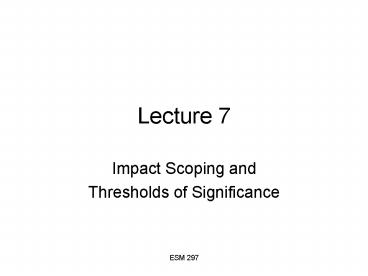Impact Scoping and - PowerPoint PPT Presentation
1 / 28
Title:
Impact Scoping and
Description:
establishes the level of review necessary. Scoping. identifies the key ... categorise the impacts that require study. establish a strategy for addressing them ... – PowerPoint PPT presentation
Number of Views:86
Avg rating:3.0/5.0
Title: Impact Scoping and
1
Lecture 7
- Impact Scoping and
- Thresholds of Significance
2
Screening and scoping compared
- Screening
- determines the requirement for EIA
- establishes the level of review necessary
- Scoping
- identifies the key issues and impacts
- establishes the terms of reference
3
Generalized EIA Process Regulatory Framework
4
NEPA Process
5
(No Transcript)
6
Scoping
- early step begins once screening completed
- open, interactive process involves the public
- lays the foundation of an EIA by identifying
- - boundaries of the EIA study
- - the information necessary for decision-making
- - key issues and significant impacts to be
considered
7
Key objectives of scoping
- inform and identify stakeholders
- find out stakeholder concerns
- consider feasible and practical alternatives
- identify the main issues and impacts to be
studied - define the boundaries of the EIA study
- agree on means of public involvement and methods
of analysis - establish protocols and methodologies
8
The conduct of scoping
- identify range of concerns
- evaluate them to determine key issues
- categorise the impacts that require study
- establish a strategy for addressing them
9
Impact identification methods
- checklists
- matrices
- networks
- overlays and geographical information systems
(GIS) - expert systems
- professional judgement
10
Advantages and disadvantages of impact
identification methods
11
An environmental impact
(Wathern, 1988)
12
Methods of impact prediction
- best estimate professional judgement
- quantitative mathematical models
- experiments and physical models
- case studies as analogues or references
13
Significant Effect on Environment
- a substantial, or potentially substantial,
adverse change in any of the physical conditions
within the area affected by the project including
land, air, water, minerals, flora, fauna, ambient
noise, and objects of historic or aesthetic
significance - CEQA
14
Thresholds of Significance
- That level at which the Lead Agency finds the
effects of the project to be significant - A quantitative or qualitative standard, or set of
criteria, pursuant to which the significance of a
given environmental effect may be determined
15
Thresholds of Significance
16
Key elements for assessing impact significance
- environmental standards
- level of public concern
- scientific and professional evidence concerning
- - resource loss/ecological damage
- - negative social impacts
- - foreclosure of land and resource use options
17
Basis for Thresholds of Significance
- A health-based standard such as air pollutant
emission standards, water pollutant discharge
standards, or noise levels. - Service capacity standards such as traffic level
of service, water supply capacity, or waste
treatment plant capacity. - Ecological tolerance standards such as physical
carrying capacity, impacts on declared threatened
or endangered species, loss of prime farmland, or
wetland encroachment. - Cultural resource standards such as impacts on
historic structures or archaeological resources. - Other standards relating to environmental quality
issues
18
Guiding principles for determining impact
significance
- use established procedure or guidance
- adapt relevant criteria or comparable cases
- assign significance rationally and defensibly
- be consistent in the comparison of alternatives
- document the reasons for judgements
19
Test for significance by asking three questions
- Are there residual environmental impacts?
- If yes, are these likely to be significant or
not? - If yes, are these significant effects likely to
occur?
20
Impact significance criteria
- environmental loss and deterioration
- social impacts resulting from environmental
change - non-conformity with environmental standards
- probability and acceptability of risk
21
Ecological significance criteria
- reduction in species diversity
- habitat depletion or fragmentation
- threatened, rare and endangered species
- impairment of ecological functions e.g.
- disruption of food chains
- decline in species population
- alterations in predator-prey relationships.
22
Social significance criteria
- human health and safety
- decline in important resource
- loss of valued area
- displacement of people
- disruption of communities
- demands on services and infrastructure
23
Environmental standards
- limits on effluent discharge concentrations
- clean air standards, water quality standards
- policy objectives and targets
- plans or policies that protect or limit use of
natural resources
24
Practical guidance
- Impacts are likely to be significant if they
- are extensive over space or time
- are intensive in concentration or in relation to
assimilative capacity - exceed environmental standards or thresholds
- do not comply with environmental policies/ land
use plans - affect ecological sensitive areas and heritage
resources - affect community lifestyle, traditional land uses
and values
25
Examples
- CERES
- http//ceres.ca.gov/planning/ceqa/thresholds.html
- Ventura County Initial Study Assessment
Guidelines Thresholds of Significance - http//www.ventura.org/planning/pdf/ordinances/ini
tial_study_assess_guide.pdf
26
Urban Environmental Problems
- All environmental problems related to land use
- Environmental Management Land Use Planning
- Need to understand land use policy
27
Land Use Policy
- Primarily set by local agencies in U.S. (cities
and counties) - Policies for the use, intensity, performance
standards, and location of land uses - 2 components
- Non-spatial (use, intensity, performance
standards) - Spatial (land use map)
28
Land Use Policies
29
(No Transcript)

